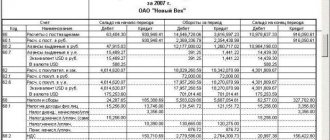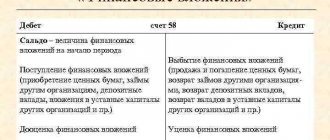Account 71 in accounting: what is it used for
At the enterprise, by order of the manager, a list of accountable persons is introduced to whom money can be issued for established purposes. Since it is mandatory that after the activities for which employees were allocated money are carried out, a report is required to be submitted to the accounting department with documents confirming the expenditure attached, these persons are accountable.
The current rules for settlements with accountants are regulated by the procedure for conducting cash transactions. In addition to company employees, citizens engaged under contract agreements can also act as accountable persons.
The chart of accounts provides that account 71 must be used to account for settlements with accountable persons.
It reflects information about the occurrence of the employee’s debt to the organization for the amounts issued to him, as well as its repayment by submitting expenses according to the advance report.
The company’s debt to the accountable person is also reflected here if he spent his own funds for production purposes. By order of the manager, it is reimbursed in the approved amount upon acceptance of the advance report.
Important! Loans issued to employees cannot be taken into account in this account. For this purpose, a separate account 73 is used. Many business entities try to disguise loans provided to employees for short periods under the issuance of accountable amounts. However, this is a violation of the law.
Accountable amounts must be issued only for the purposes established in the order and the employee must report for them within a certain time frame or return the money. During inspections, the Federal Tax Service may identify these cases and assess additional taxes and fines.
To record settlements with accountable persons, you need to use journal order No. 7, which reflects during the month all expenses made by the accountable person, amounts issued for reporting, etc.
What requirements apply when issuing accountable money?
Accounting must strictly control the amounts issued for reporting. There are several main requirements for transactions with accountable persons:
- Money can only be given to company employees;
- You can issue money by transfer to an employee’s account or corporate card or from the company’s cash desk - the method is fixed in the accounting policy;
- the maximum amount of money is limited by order of the manager;
- the daily allowance limit for travel expenses is approved by a separate provision;
- the deadline for submitting the report is fixed in the accounting policy or regulation;
- all calculations must be confirmed - the employee must attach tickets, checks, invoices, receipts, and so on to the advance report.
They issue money at the request of the employee or by order of management.
Keep records of exports and imports in the Kontur.Accounting web service. Simple accounting, payroll and reporting in one service
Account characteristics
Synthetic accounting of settlements with persons to whom accountable amounts have been issued is organized on account 71. To answer whether this account is active or passive, you need to remember that its balance can be located either as a debit or as a credit. Thus, account 71 is an active-passive account with a double balance.
The balance at the beginning of the period in the debit of the account reflects the debt of the company's accountable persons for the money issued to them for established purposes. The account credit balance records the company's debt to the employee for expenses incurred at his own expense in the interests of the organization.
The debit of account 71 reflects the issuance of money for the purposes established by the enterprise or reimbursement to the employee of expenses approved by management that were previously made at his expense.
The credit of the account reflects the approved expenses of the accountable person, which are accepted by management, as well as the return of unspent funds to the cash desk or withholding them from the salary of the accountable person, if they are presented with an application for this method of repaying the debt.
To determine the ending balance, you must use the following algorithm:
- If the opening balance on account 71 is in debit, then you need to add the debit turnover on the account to it and subtract the amounts for the selected period on the loan. If you get a positive value, then the balance at the end will be a debit. Otherwise, it is reflected in the credit of the account.
- If the opening balance on account 71 is located in the credit of the account, then the turnover on the credit of the account should be added to it and subtract the total amount of movement on the debit of the account for the period under review. If the total value is greater than zero, it must be reflected as a credit to the account. A negative amount must be reflected in the debit of the account.
You might be interested in:
Chart of accounts for 2021 with explanations and entries
Purpose of account 71
Account 71 is intended to account for settlements of the employing organization with accountable persons - with employees under employment contracts or individual contractors under civil and industrial enterprises, who have been issued funds to spend in the interests of the employer:
- as part of a business trip;
- for the purchase of goods, materials, fixed assets for the organization;
- to make other expenses in the interests of the organization;
- for settlements with counterparties (if it is not possible to use a regular current account for these purposes).
Issuing money on account sometimes solves another problem - it is an “emergency” way to avoid exceeding the cash register limit: if the limit is approaching or is actually exceeded by the end of the day, then the excess at the end of the shift can be given to the responsible employee for a minimum period.
The employee who took the money on account must account for it. To do this, he draws up an advance report and attaches primary documents confirming expenses to it.
Based on the advance report and the documents attached to it, the accountant determines who owes whom and how much: the employee owes the employer (if the advance report is drawn up for an amount less than what was paid out) or the employer to the employee (if the employee spent more than what was paid out).
Correspondence
Account 71 can participate in transactions with many accounts.
According to the debit of account 71, he can correspond to the credit of accounts:
- Account 50 - when issuing imprest amounts from the cash register;
- Account 51 - when transferring accountable amounts from a current account to a card;
- Account 52 - when issuing accountable amounts in foreign currency (for example, when traveling abroad);
- Account 55 - when issuing a report from special accounts;
- Account 76 - when issuing money, reporting according to the bank register;
- Account 79 - when issuing the account at the expense of the branch, separate division;
- Account 91 - when writing off exchange rate differences if the funds were issued in foreign currency.
By crediting the account, it can enter into transactions with the debit of the following accounts:
- Account 07 - when registering equipment for further installation purchased through accountable amounts;
- Account 08 - when reflecting costs (business trips, other costs) associated with the acquisition of non-current assets;
- Account 10 - when purchasing materials using imprest amounts;
- Account 11 - when purchasing animals for fattening using accountable amounts;
- Account 15 - when purchasing materials, if the accounting policy stipulates accounting using account 15;
- Account 20 - when writing off accountable amounts for the main production;
- Account 23 - when writing off accountable amounts for auxiliary production;
- Account 25 - when writing off accountable amounts for general production expenses;
- Account 26 - when writing off accountable amounts for administrative expenses;
- Account 28 - when writing off accountable amounts to correct a previously committed defect;
- Account 29 - when writing off accountable amounts for the costs of service and subsidiary farms;
- Account 41 - when reflecting the acquisition of goods through reporting;
- Account 44 - when writing off accountable amounts for the costs of selling products;
- Account 45 - when writing off accountable amounts for the purchase of goods that have not yet arrived at the organization;
- Account 50 - when returning unused imprest amounts to the cash desk;
- Account 51 – when returning unused imprest amounts to the current account;
- Account 52 – when returning unused imprest amounts to a foreign currency account;
- Account 55 – when returning unused imprest amounts to a special bank account;
- Account 70 - when deducting unreturned accountable amounts from wages (one-time deduction);
- Account 73 – when deducting unreturned accountable amounts from wages (multiple deduction);
- Account 76 - when closing a debt to a supplier for previously written off work or services;
- Account 79 - when transferring debt between branches and parent organizations;
- Account 91 - when reflecting a shortage of purchased materials within the limits of natural loss, when reflecting exchange rate differences when issuing a report in foreign currency;
- Account 94 - when reflecting a shortage, if the expenditure of the accountable amount is not confirmed by documents and it is not returned to the cash desk;
- Account 97 - when reflecting accountable costs that will be written off in future periods;
- Account 99 - when writing off accountable funds for liquidation of emergency situations and natural disasters.
Accounting for business and operational accountable amounts
Goods purchased with cash issued on account are recorded in the accounts of non-current assets, inventories or goods.
Let's consider an example: 3,000 rubles were issued from the cash register for the purchase of materials, of which 2,500 rubles were actually spent. The accountant makes the following entries:
- DT “Calculations for accountable amounts” CT “Cash desk” – 3000 rub. – issued to an accountable person for the purchase of materials.
- Dt “Materials” Kt “Calculations for accountable amounts” – 2500 rub. – reflects the amount of expenses for materials.
- Dt “Cash desk” Kt “Settlements for accountable amounts” – 500 rub. – the accountable person returned unused funds to the cash desk.
If the remaining accountable amounts are not returned by the employee within the prescribed period, or an advance report on the funds spent has not been provided, the following posting is made: Dt 94 Kt 71. Depending on the method of withholding the amount, postings can be made:
- Dt “Payroll calculations” Kt “Shortages and losses” – deduction of the accountable amount from the employee’s salary;
- DT “Settlements with employees for other transactions” DT “Shortages and losses” – the employee’s receivables for the unreturned accountable amount are displayed.
Before using account 71 in accounting to draw up correspondence on transactions for recording and collecting accountable amounts from an employee, you need to familiarize yourself with the accounting policies of the enterprise. In special cases with a score of 71, accounts 91 and 99 can also be used.
The procedure for issuing money for reporting
The issuance of funds to an employee can be carried out in several ways.
You might be interested in:
Account 03 in accounting “Profitable investments in material assets”, what is taken into account, correspondence of accounts, postings
The simplest and most common way is to issue money from the cash register. In this case, the cashier, at the time of issue, formalizes the operation with an expense cash order.
Until mid-2021, when issuing money, the employee must fill out an application for the issuance of the amount. This had to be done by any employee of the organization, including the director. Applications were allowed not to be filled out when reimbursing excess reporting and issuing daily allowances for business trips.
Since 2021, changes have been made to this procedure. The company can continue to use statements, or issue an order from the manager, which will indicate the full name. accountants, amounts and deadlines for reporting on funds received.
Attention! If there is no application or order, or if they are drawn up incorrectly, fines of up to 50 thousand rubles may be imposed on the company and responsible persons.
The application for the director should differ from the forms of ordinary employees - in it he does not ask for a report, but gives an order to perform this action.
The latest amendments to the procedure for cash transactions allow the issuance of a new amount if the employee has not yet reported the old one. Previously, such a step was prohibited.
In addition to cash, reports can also be issued by transferring from a current account to an employee’s card. For this step, he fills out an application and includes in it the bank details for making the payment.
If the application is not completed, the tax authority, upon inspection, will decide that income (salary) was transferred and will charge additional personal income tax on the amount. Also, the payment order must indicate that it is the issuance of the report.
If the issue is made to a card, then the employee can attach a receipt from the terminal, ATM, bank statement and similar forms as a supporting document. If the employee is on a business trip and an additional daily allowance is transferred to him, then there is no need to fill out another application. But you will need to report all amounts at the same time.
Attention! If the employee has not spent the accountable amount in full, then after completing the advance report, he must return the unused balance back to the cashier
What to show on account 71
Order of the Ministry of Finance of the Russian Federation No. 94n approved that account 71 “Settlements with accountable persons” is intended to reflect transactions for the issuance and return of accountable amounts.
What is a subreport? This is a certain amount of money from the organization that is transferred to the employee for specific purposes. Moreover, the purpose of expenses and the reporting period are strictly limited. After the allotted time has passed, the subordinate must provide a report on the expenses incurred. In simple words, money is given in advance, but with the condition that the employee provides a report - this is the essence of reporting.
For example, the company secretary was given 100 rubles from the cash register to buy an envelope and send a letter. When the reporting employee sends the letter, he will be given a receipt or check at the post office. It is these payment documents that the secretary will attach to the report, which will confirm the fact that the funds were spent on purpose.
For what purposes can a report be issued:
- Advance on travel expenses. This is relevant when an employee is sent on a business trip. Travel allowances include payment for accommodation and travel, daily allowances and other expenses en route.
- Expenses for the business needs of the company. Money can be issued for any purpose, from buying a light bulb for a utility room to building materials for major repairs.
- Settlements with counterparties. For example, the issuance of money is subject to payment for the services of third-party organizations. The operation is used less and less often, since non-cash payments are much more convenient.
- Other goals fixed by the decision of the company management. The director has the right to order the issuance of a report for any purpose. For example, for the purchase of equipment, exclusive rights, software products, etc.
IMPORTANT!
Loans and advances to employees cannot be reflected in account 71. For this purpose, a separate account is provided in accounting - 73. Some companies, wanting to simplify accounting and evade taxes, issue short-term loans to employees through 71 accounts. This is a violation.
What expenses can you give money for?
The legislative framework contains instructions for what purposes accountable amounts can be issued, these include:
- Payment for business trips and similar trips;
- Payment for services or work;
- Purchase of materials and goods;
- Incurring entertainment expenses;
- Other similar expenses.
An organization can establish the areas on which accountable persons have the right to spend the amounts issued to them by issuing an Accountability Regulation.
Important! The law prohibits the issuance of accounting funds for the acquisition of fixed assets. Also, accountable amounts cannot be used to make one-time transactions with organizations and entrepreneurs, the amount of which exceeds 100 thousand rubles.
Statement of balances on account 71 “Settlements with accountable persons”
| Full name, position | Amount, rub. |
| Debit | Credit |
| Zhukov V.A. - caretaker | |
| Voronova T. A. - engineer | |
| Total |
| No. | Contents of operation | Amount, rub. |
| 1. | Advance report No. 10 Voronova T. A. dated July 5 Written off for travel expenses | 4 000 |
| 2. | The balance of V.A. Zhukov’s accountable amounts was withheld from his salary. | |
| 3. | Expenditure cash order No. 1 dated June 3. Issued to Makarov 0. I. for business expenses | 4 000 |
| 4. | Advance report No. 11 Makarov 0. I. dated June 5: 3) spent on the purchase of stationery 4) on the purchase of fuel | 3 600 |
| 5. | Expense cash order No. 2 dated June 16. Issued to Makarov 0. I. overexpenditure according to advance report No. 11 | |
| 6. | Expense cash order No. 3 dated June 18. Issued on account of travel expenses to E.N. Petrov. | 8 000 |
Task 1.23
Compile journal order No. 7 for settlements with accountable persons for April.
Balances of settlements with accountable persons for April.
| Last name I.O. | Job title | Date of origin | Amount, rub. |
| Debit | Credit | ||
| 1. Sokolov A.I. | agent | March 29 | |
| 2. Petrov E.N. | forwarder | 30th of March | |
| Z. Zhukova O.A. | manager | 30th of March | |
| Total |
Operations for April
| date | Name of the document and its contents | Amount, rub. |
| 2.04 | Expenditure cash order No. 15 An overexpenditure of accountable amounts was issued to E. N. Petrov. | |
| 2.04 | Expense cash order No. 16. An advance was issued for a business trip to the chief accountant A. Yu. Kalacheva. | 6 500 |
| 5.04 | Advance report No. 20 Sokolova A.I. Spent on paying for fuel delivery | |
| 5.04 | Cash receipt order No. 17. Issued to manager Zhukova 0. A. for the purchase of office supplies. | 1 000 |
| 7.04 | Expenditure cash order No. 18. An overexpenditure of accountable amounts was issued to Sokolov A.I. | ? |
| 10.04 | Advance report No. 21. The report of the chief accountant Kalacheva A. Yu. was submitted - /jL | 6 000 |
| 13.04 | Receipt cash order No. 10 Accepted the balance of accountable amounts Kalacheva A. Yu. | ? |
| 15.04 | Advance report No. 22. An advance report was submitted to Zhukova 0. A. for purchased office supplies. | 1 200 |
| 16.04 | Expenditure cash orders No. 19,20. A report was issued from the cash register to: Zhukova 0. A. for payment of postal services to Petrov E. N. for business and operating expenses |
Appendix to problem 1.23
Journal-warrant No. 7
on the credit of account 71 “Settlements with accountable persons” for April 2014.
(rub.)
| No. | date | Advance report | Full name of the reporting person | Serial number according to the order journal for the last month | Balance at the beginning of the month | Issued on report | |
| Date of origin | Sum | date | Cor. check | Sum | |||
| Debit | Credit | ||||||
| 1. | |||||||
| 05.04.14 | Sokolov A.I. | March 29 | — | — | — | — | |
| Petrov E.N. | 30th of March | — | 16.04.14 | 50.1 | |||
| 15.04.14 | Zhukova O.A. | 30th of March | — | 07.04.14 | 50.1 | ||
| 10.04.14 | Kalacheva A.Yu. | — | — | — | — | 02.04.14 | 50.1 |
| Total: |
End of journal-order No. 7
| No. | Issued as compensation for overexpenditure | Unused amounts returned | Spent from accountable amounts | Balance at the end of the month | |||||
| date | Cor. check | Sum | date | Cor. check | Sum | According to the approved report | Including debit accounts | Debit | Credit |
| 60.1 | 10.9 | ||||||||
| 07.04.14 | 50.1 | — | — | — | — | — | |||
| 02.04.14 | 50.1 | — | — | — | — | — | — | — | — |
| 16.04.14 | 50.1 | — | |||||||
| — | — | — | 13.04.14 | 50.01 | — | — | — | — |
ACCOUNTING ON SPECIAL ACCOUNTS IN BANKS
Typical accounting entries
Let's look at how, in typical situations, accounting entries are made for reporting for dummies.
Purchasing materials through reporting
| Debit | Credit | Name of the situation |
| 71 | 50/1 | Money issued, report from the cash register |
| 71 | Materials were purchased for accountable amounts | |
| 19 | 71 | Accepted for VAT accounting on purchased materials |
| 10 | Purchased materials were released into production | |
| 50/1 | 71 | The person handed over the unspent balance of the accountable amount to the cashier |
| 71 | 50/1 | The accountable person was issued an overexpenditure on the accountable amounts from the cash register |
Travel expenses
| Debit | Credit | Name of the situation |
| 71 | 50/1 | Money was issued according to the cash register for a business trip |
| 20 | 71 | Expenses for purchasing travel tickets have been written off |
| 19 | 71 | Accepted for VAT accounting on purchased tickets |
| 44 | 71 | Hotel expenses and daily allowances written off |
| 19 | 71 | Accepted for VAT accounting for hotel stays |
| 50/1 | 71 | The accountable person returned the remaining funds to the cash desk |
Example No. 1. Overspending - debt in favor of an accountable employee
Vesna LLC issued in June to secretary P.P. Karandashikov. 3000 rubles for the purchase of pencils. The funds were issued from the cash register. The employee made a purchase in the amount of 3,150 rubles. An advance report was drawn up on the costs incurred, a fiscal receipt and a delivery note were attached to the documents.
Postings:
| Operation | Debit | Credit | Amount, rub. |
| The report was issued from the cash register | 71 | 50 | 3000 |
| The advance report has been approved, the expenses for the purchase of pencils have been taken into account | 10 | 71 | 3150 |
| The overspending was transferred to the secretary's bank card | 71 | 51 | 150 |









